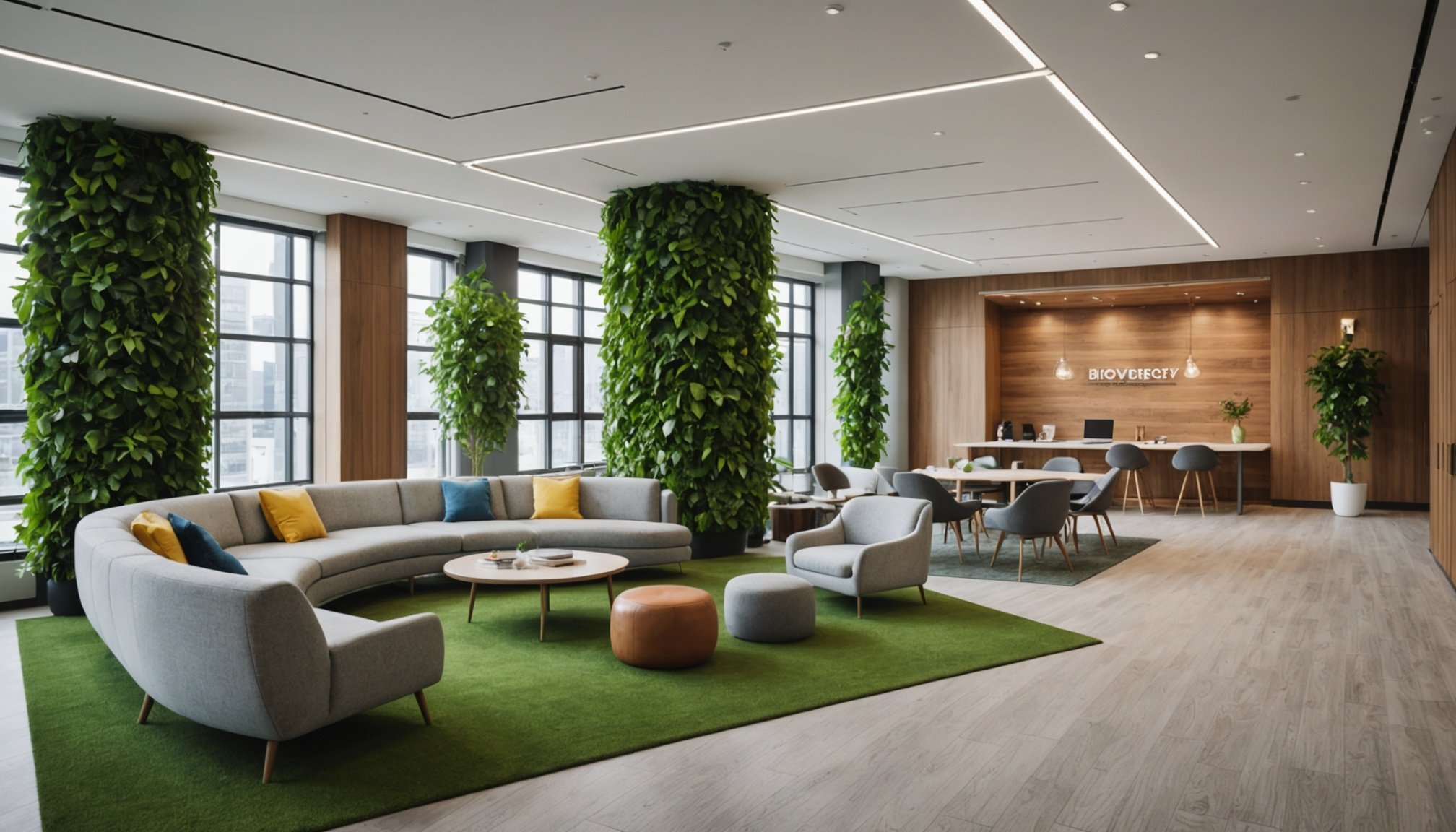Unveiling the Synergy: The Impact of Biophilic Design on Employee Well-Being in the Workplace to Biophilic Design
Biophilic design, a concept that integrates elements of nature into the built environment, has been gaining significant attention in recent years for its profound impact on human health and well-being. This approach, rooted in the Biophilia Hypothesis proposed by sociobiologist E.O. Wilson, suggests that humans have an innate affinity for life and natural systems. When we incorporate natural elements into our workplaces, the results can be transformative.
The Science Behind Biophilic Design
Biophilic design is more than just an aesthetic trend; it is a scientifically-backed strategy to improve occupant health, productivity, and mental well-being. Research consistently shows that biophilic design elements such as natural light, air, plants, and natural materials have a positive impact on employees.
Have you seen this : Create your blissful morning routine: a mindfulness blueprint for stress reduction
Key Benefits of Biophilic Design
- Stress Reduction: The presence of plants, trees, and green spaces in workplaces has been shown to reduce stress levels and improve cognitive function[2][3].
- Improved Mental Health: Biophilic design can lower blood pressure and create a calming atmosphere, contributing to better mental health outcomes[2][3].
- Enhanced Productivity: Natural light helps regulate circadian rhythms, boosting energy levels and fostering higher productivity and creativity[2].
- Better Air Quality: Incorporating natural materials like wood, stone, and bamboo can improve air quality, enhancing occupant well-being[2].
Creating Restorative Environments
The ultimate goal of biophilic design is to create spaces that transcend mere functionality to become restorative environments. Here’s how this can be achieved:
Nature in the Space
- Direct Elements: Incorporating direct elements like plants, water features, or dynamic light can significantly enhance the workplace environment. For example, the presence of green spaces in urban environments and workplaces reduces stress and improves cognitive function[2][3].
- Natural Light: Introducing natural light into workplaces or healthcare settings has profound effects, including regulating circadian rhythms and boosting energy levels[2].
Natural Analogues
- Natural Materials: Using natural materials, patterns, and textures can evoke a connection to nature. For instance, opting for wooden handrails instead of metal or choosing carpets with organic, nature-inspired patterns can create a calming ambiance[1][2].
- Textured Surfaces: Incorporating textured surfaces like stone or bamboo can lower stress levels and improve occupant well-being[2].
Nature of the Space
- Spatial Configurations: Designing layouts that emulate natural spatial configurations, such as refuges or expansive vistas, can foster a sense of community and belonging. Zoning spaces with soft boundaries enables individuals to flow through a building seamlessly, without feeling isolated[1][3].
Enhancing Workplace Culture through Biophilic Design
Biophilic design is not just about individual well-being; it also plays a crucial role in fostering a positive and resilient workplace culture.
Have you seen this : Revolutionizing art engagement: creative therapeutic programs in museums for visitors battling mental health issues
Fostering Community
- Shared Spaces: Creating shared areas for spontaneous interactions fosters a sense of agility and offers opportunities for mindful pauses that encourage meaningful connections. This approach cultivates pride and a strong connection to the workplace, making employees feel valued and engaged[1].
- Recruitment and Retention: A well-designed environment can make offices more attractive to both current staff and prospective hires, addressing broader workforce challenges such as recruitment and retention[1].
Employee Satisfaction and Productivity
- Job Satisfaction: When employees feel comfortable and inspired in their surroundings, their productivity and satisfaction increase. Natural tones, soothing textures, and elements that reflect the outdoors contribute to a positive workplace culture[1].
- Occupational Health: Biophilic design interventions help create an atmosphere that is both welcoming and grounding, particularly in high-stress sectors like healthcare and defense. This approach supports occupational health by reducing stress and improving mental well-being[1][2].
Practical Insights and Actionable Advice
Implementing biophilic design in your workplace is more accessible than you might think. Here are some practical tips and insights:
Starting Small
- Subtle Design Choices: Simple design choices, such as using natural materials or incorporating nature-inspired patterns, can significantly influence the way a space is perceived. For example, choosing carpets with organic patterns over geometric ones can create a calming ambiance[1].
- Greenery: Adding plants or green walls to your office can be a cost-effective and immediate way to introduce biophilic elements. This not only improves air quality but also reduces stress levels[2].
Integrating Biophilic Elements into Existing Spaces
- Zoning Spaces: Even within the confines of existing structures, integrating nature-inspired design choices can foster a sense of cohesion and belonging. Zoning spaces with soft boundaries enables seamless movement and creates shared areas for interactions[1].
- Lighting: Improving natural light exposure can be as simple as rearranging furniture or using mirrors to reflect natural light deeper into the space[2].
Case Studies and Examples
Real-world examples illustrate the transformative impact of biophilic design:
Defence Sector
- Transformative Impact: In the Defence sector, biophilic design has been seen to create an atmosphere that is both welcoming and grounding, even in the most challenging settings. This approach helps individuals feel a connection to the environment around them, even when they’re far from home[1].
Mass Timber Buildings
- Sustainable and Healthy: Buildings like the Black and White Building in London demonstrate the growing trend of using timber as a sustainable and healthy building material. These buildings improve air quality, enhance acoustics, and reduce the energy required for heating and cooling[2].
The Future of Biophilic Design
As we move forward, the importance of biophilic design is only set to grow.
The Biophilic Framework
- Comprehensive Guide: The Biophilic Framework, updated by Terrapin Bright Green, offers a comprehensive guide for creating spaces that prioritize health, well-being, and connection. This framework organizes biophilic design into three key categories: Nature in the Space, Natural Analogues, and Nature of the Space[3].
- New Patterns: The 10th Anniversary Edition includes a new pattern, Awe, which explores stimuli that defy expectations and lead to transformative experiences. This addition highlights the evolving nature of biophilic design and its continuous adaptation to new research and insights[3].
Biophilic design is more than just a design trend; it is a powerful tool for creating environments that support human well-being, productivity, and resilience. By integrating natural elements into our workplaces, we can foster a sense of community, improve mental health, and enhance overall job satisfaction.
Final Thoughts
As Bill Browning, founder of Terrapin Bright Green, puts it, “The spaces we inhabit significantly affect our psychological, physiological, and neurological states. Biophilic design aims to create environments where people thrive.”[3]
Incorporating biophilic design into your workplace is not just about creating beautiful spaces; it’s about creating environments that inspire and sustain those who inhabit them. Whether through subtle design choices or more extensive architectural changes, the impact of biophilic design on employee well-being is undeniable.
Table: Comparing Traditional and Biophilic Office Design
| Design Element | Traditional Office Design | Biophilic Office Design |
|---|---|---|
| Lighting | Artificial lighting | Natural light, dynamic light |
| Materials | Synthetic materials | Natural materials (wood, stone, bamboo) |
| Air Quality | Often poor due to lack of ventilation | Improved through natural ventilation and greenery |
| Stress Levels | Higher due to lack of natural elements | Lower due to presence of plants, green spaces |
| Productivity | Variable, often lower due to monotony | Higher due to improved mental health and well-being |
| Employee Satisfaction | Lower due to lack of connection to nature | Higher due to sense of community and belonging |
| Environmental Impact | Higher energy consumption, lower biodiversity | Lower energy consumption, higher biodiversity |
Detailed Bullet Point List: Implementing Biophilic Design in Your Workplace
- Conduct a Site Analysis: Assess the existing natural elements around your workplace, such as sunlight, wind patterns, and surrounding greenery.
- Incorporate Greenery: Add plants or green walls to improve air quality and reduce stress levels.
- Use Natural Materials: Opt for natural materials like wood, stone, and bamboo in your interior design.
- Enhance Natural Light: Rearrange furniture to maximize natural light exposure or use mirrors to reflect light deeper into the space.
- Create Shared Spaces: Design shared areas for spontaneous interactions to foster a sense of community.
- Incorporate Water Features: Use waterscapes like ponds, streams, or fountains to create a calming atmosphere and tap into the “blue mind effect.”
- Design for Awe: Incorporate elements that inspire wonder and transform perceptions, such as expansive vistas or unique natural features.
- Monitor and Adjust: Continuously monitor the impact of biophilic design elements and make adjustments based on feedback and new research.
By embracing biophilic design, you can create a workplace that not only supports the well-being of your employees but also contributes to a more sustainable and resilient built environment.

